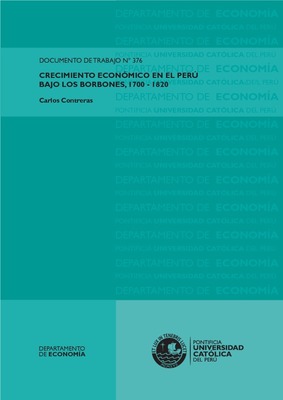| dc.contributor.author | Contreras, Carlos | |
| dc.date.accessioned | 2015-03-19T20:37:57Z | |
| dc.date.available | 2015-03-19T20:37:57Z | |
| dc.date.issued | 2014 | |
| dc.identifier.uri | http://repositorio.pucp.edu.pe/index/handle/123456789/47017 | |
| dc.description.abstract | El siglo dieciocho fue uno de robusto crecimiento económico en el virreinato del Perú. Pero tanto la cronología, cuanto las raíces de este crecimiento son imprecisas. El inicio de la expansión suele ubicarse hacia el final de la gran epidemia de 1718-1723, que afectó a la población indígena de la sierra sur, ocasionando severos problemas inmediatos al flujo comercial, así como al suministro de trabajadores para las haciendas y minas en los años siguientes. Pero otros han apuntado al efecto que tuvieron ciertas medidas relacionadas a la tributación minera y a la introducción de nuevas tecnologías en ese sector, hacia 1736-1745. El final del ciclo de crecimiento se ubicaría hacia 1800 o, en todo caso, durante la primera década del siglo diecinueve. Se trataría, así, de un ciclo de crecimiento que habría durado unos tres cuartos de siglo, lo que lo convertiría en uno de los más prolongados de la historia económica peruana. El papel que en este proceso tuvieron las reformas borbónicas es otro tema de debate. En este documento me propongo ordenar la información pertinente a este proceso de crecimiento económico, así como reflexionar acerca de sus determinantes. | es_ES |
| dc.description.abstract | The eighteenth century was one of robust economic growth in the Viceroyalty of Peru. But both the chronology, the roots of this growth are imprecise. The beginning of the expansion is usually located towards the end of the great epidemic of 1718-1723, which affected the indigenous population of the southern highlands, causing severe problems to immediate trade flow and the supply of workers for the plantations and mines in subsequent years. But others have pointed to the effect that certain measures were related to the mining tax and the introduction of new technologies in this sector, towards 1736-1745. The end of the growth cycle would be located around 1800 or, in any case, during the first decade of the nineteenth century. It thus would be a growth cycle that would have lasted about three quarters of a century, which would make it one of the longest of the Peruvian economic history. The role that this process had the Bourbon reforms is another topic of debate. In this paper I intend to order the relevant information to the process of economic growth, as well as reflect on its determinants. | en_US |
| dc.language.iso | spa | es_ES |
| dc.publisher | Pontificia Universidad Católica del Perú. Departamento de Economía | es_ES |
| dc.relation.ispartof | urn:issn:2079-8466 | |
| dc.relation.ispartof | urn:issn:2079-8474 | |
| dc.relation.ispartofseries | Documento de Trabajo;376 | es_ES |
| dc.rights | info:eu-repo/semantics/openAccess | es_ES |
| dc.rights.uri | http://creativecommons.org/licenses/by-nc-nd/2.5/pe/ | * |
| dc.subject | Crecimiento económico--Perú--Siglo XVIII | es_ES |
| dc.subject | Historia económica--Perú--Siglo XVIII | es_ES |
| dc.title | Crecimiento económico en el Perú bajo los borbones, 1700-1820 | es_ES |
| dc.title.alternative | Economic growth in Peru under the Borbons: 1700-1820. | en_US |
| dc.type | info:eu-repo/semantics/workingPaper | |
| dc.type.other | Documento de trabajo | |
| dc.subject.ocde | http://purl.org/pe-repo/ocde/ford#5.02.00 | |
| dc.publisher.country | PE | |
| renati.advisor.orcid | https://orcid.org/0000-0001-7691-2362 | |


